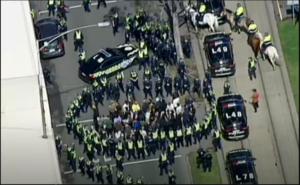Unveiling Digital Ketteling: How Social Media Algorithms Silence Voices
@claudiaalicklove Replying to @Claudia Alick Ketteling is confinement by police or use of fencing of a group of demonstrators or protesters into a small area, as a method of crowd control. Digital Kettling is a method of platforms to reduce the distribution in visibility of protest content on social media. #ketteling#kettling#crowdcontrol#campusprotests
♬ original sound – Claudia Alick
In the age of digital connectivity, social media platforms like Facebook, Instagram, Twitter, and TikTok serve as virtual town squares, where ideas are exchanged, movements are born, and voices are amplified. However, lurking beneath the surface lies a phenomenon that has profound implications for freedom of expression and the dissemination of critical information: digital ketteling.
Defining Digital Ketteling
Digital ketteling, a term inspired by the crowd control tactic used by law enforcement, refers to the subtle yet pervasive ways in which social media algorithms and content moderation practices restrict the visibility of certain content. Much like physical ketteling, which involves corralling protesters into confined spaces, digital ketteling confines dissenting voices within the echo chambers of cyberspace.
The Mechanisms of Digital Ketteling
At the heart of digital ketteling are algorithms—complex mathematical formulas designed to curate users’ online experiences. These algorithms prioritize content based on various factors, including engagement metrics, user preferences, and advertiser interests. While ostensibly aimed at enhancing user experience, these algorithms often have unintended consequences, relegating certain content to the shadows.
Algorithms and Echo Chambers
One of the primary mechanisms of digital ketteling is the formation of echo chambers—virtual spaces where users are exposed only to content that aligns with their existing beliefs and preferences. As algorithms prioritize content similar to what users have previously engaged with, dissenting voices and alternative perspectives are pushed to the periphery, reinforcing existing biases and inhibiting meaningful dialogue.
Content Moderation and Censorship
In addition to algorithmic filtering, content moderation practices employed by social media platforms can contribute to digital ketteling. Policies aimed at combating misinformation, hate speech, and graphic content often result in the inadvertent suppression of legitimate discourse on important societal issues, including genocide, human rights abuses, and political dissent.
The Impact on Anti-Genocide Efforts
The ramifications of digital ketteling are particularly stark in the realm of human rights advocacy. Efforts to raise awareness of atrocities such as genocide can be stymied when anti-genocide content is deprioritized or censored by social media algorithms. This not only limits the reach of vital information but also impedes the mobilization of support and action to address such injustices.
Conclusion: Challenging Digital Ketteling
Digital ketteling poses profound challenges to the principles of free speech, open discourse, and democratic engagement in the digital age. As social media platforms wield increasing influence over public discourse, it is imperative to scrutinize and challenge the mechanisms that perpetuate digital ketteling. By promoting transparency, accountability, and algorithmic fairness, we can strive to create online spaces where all voices are heard, and no issue is relegated to the shadows. Only then can we fulfill the promise of the digital revolution as a force for positive change and social justice.
More articles on ketteling
https://www.vox.com/2020/6/6/21282509/george-floyd-protests-kettling-new-york-nypd

